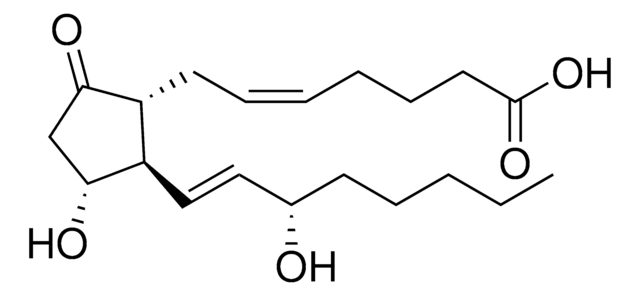L5011
Leukotriene D4
~50 μg/mL (in methanol/ammonium acetate buffer, 70:30, pH 5.6), ≥97%
Synonym(e):
LTD4
About This Item
Empfohlene Produkte
Qualitätsniveau
Assay
≥97%
Konzentration
~50 μg/mL (in methanol/ammonium acetate buffer, 70:30, pH 5.6)
Versandbedingung
dry ice
Lagertemp.
−70°C
SMILES String
CCCCC\C=C\C/C=C\C=C\C=C\[C@@H](SC[C@@H](N)C(=O)NCC(O)=O)[C@@H](O)CCCC(O)=O
InChI
1S/C25H40N2O6S/c1-2-3-4-5-6-7-8-9-10-11-12-13-16-22(21(28)15-14-17-23(29)30)34-19-20(26)25(33)27-18-24(31)32/h6-7,9-13,16,20-22,28H,2-5,8,14-15,17-19,26H2,1H3,(H,27,33)(H,29,30)(H,31,32)/b7-6+,10-9-,12-11+,16-13+/t20-,21+,22-/m1/s1
InChIKey
YEESKJGWJFYOOK-GKWRKXFUSA-N
Biochem./physiol. Wirkung
Leistungsmerkmale und Vorteile
Verpackung
Signalwort
Danger
H-Sätze
Gefahreneinstufungen
Acute Tox. 3 Dermal - Acute Tox. 3 Inhalation - Acute Tox. 3 Oral - Flam. Liq. 2 - STOT SE 1
Zielorgane
Eyes
Lagerklassenschlüssel
3 - Flammable liquids
WGK
WGK 3
Flammpunkt (°F)
49.5 °F
Flammpunkt (°C)
9.7 °C
Persönliche Schutzausrüstung
Eyeshields, Faceshields, Gloves, type ABEK (EN14387) respirator filter
Analysenzertifikate (COA)
Suchen Sie nach Analysenzertifikate (COA), indem Sie die Lot-/Chargennummer des Produkts eingeben. Lot- und Chargennummern sind auf dem Produktetikett hinter den Wörtern ‘Lot’ oder ‘Batch’ (Lot oder Charge) zu finden.
Besitzen Sie dieses Produkt bereits?
In der Dokumentenbibliothek finden Sie die Dokumentation zu den Produkten, die Sie kürzlich erworben haben.
Unser Team von Wissenschaftlern verfügt über Erfahrung in allen Forschungsbereichen einschließlich Life Science, Materialwissenschaften, chemischer Synthese, Chromatographie, Analytik und vielen mehr..
Setzen Sie sich mit dem technischen Dienst in Verbindung.








